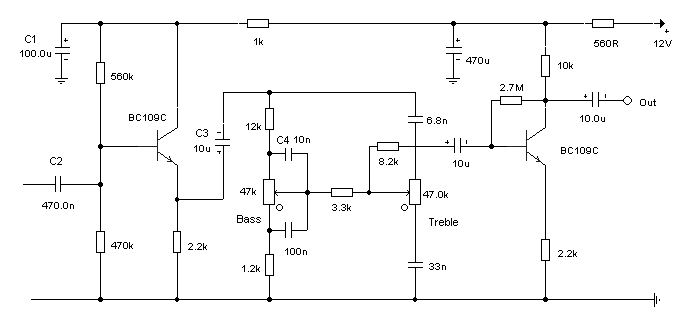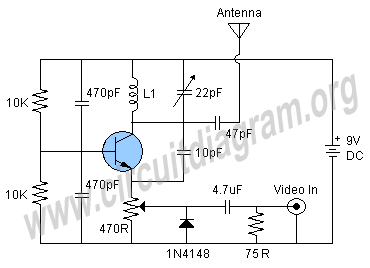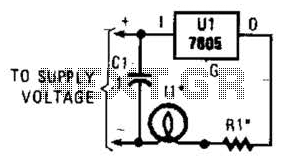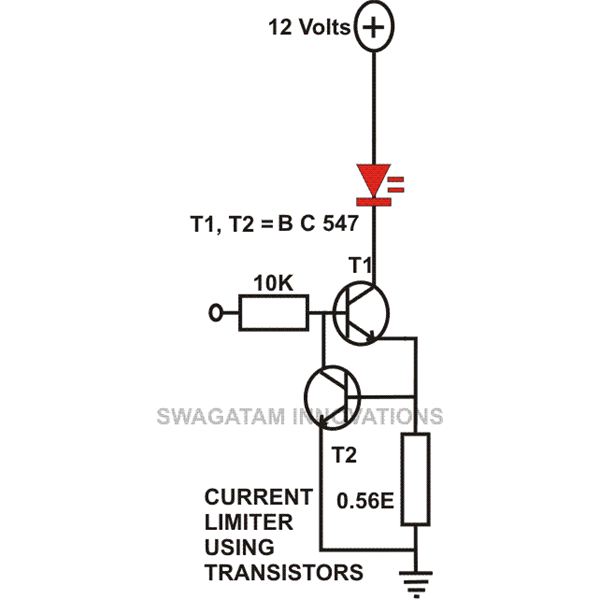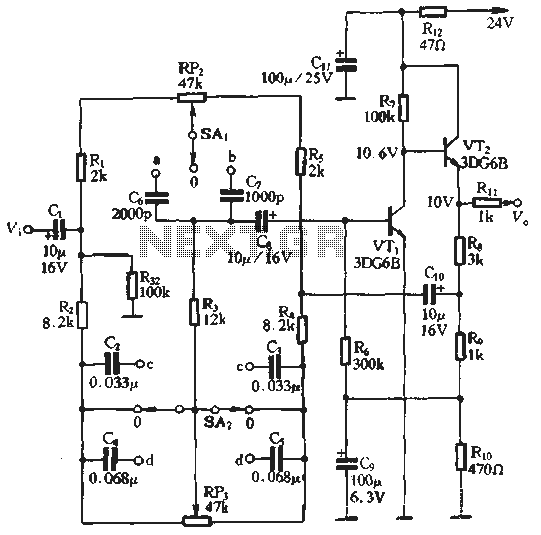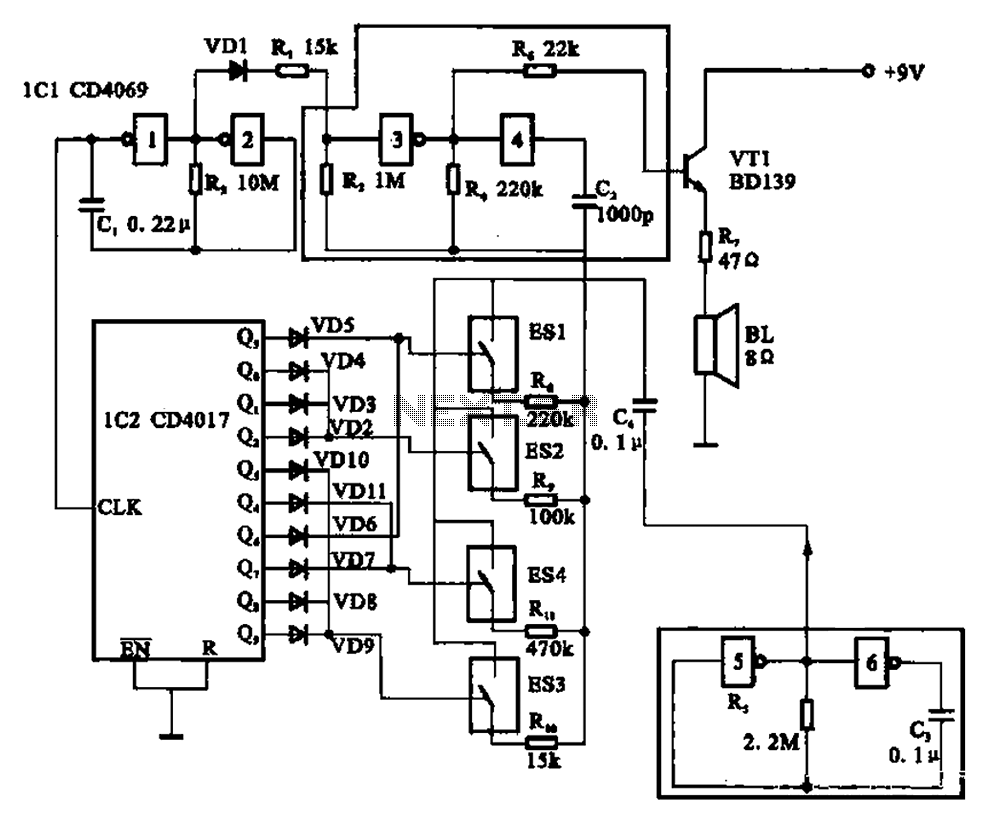
Electronic Voltmeter Ammeter Circuit Using Single IC 741
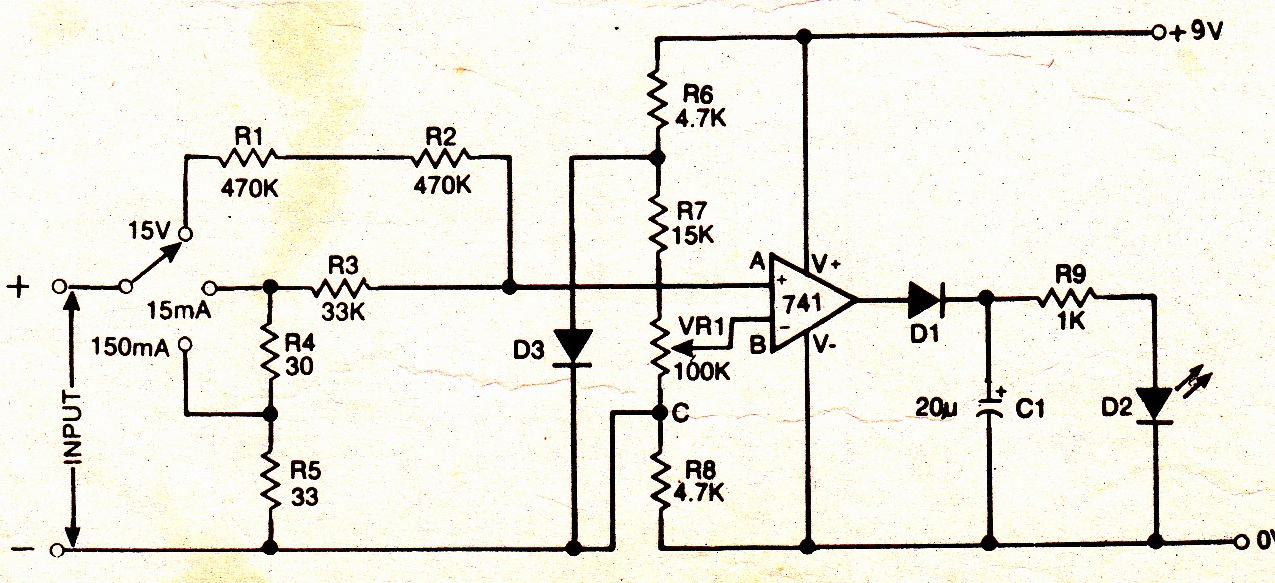
A simple electronic multimeter offers an affordable alternative for hobbyists deterred by the high cost of conventional multimeters. This device is designed to measure three ranges: (i) 0-15V, (ii) 0-15mA, and (iii) 0-150mA, with the possibility of extending the ranges through appropriate modifications. The circuit utilizes a 741 operational amplifier as a null detector. Its output is determined by the voltage difference between point A and point B, amplified by the device's high voltage gain. When the voltage at point A (VA) exceeds that at point B (VB), the output is limited to approximately 7 volts; conversely, if VA is less than VB, the output is around 2 volts. The transition point between low and high output indicates that VA equals VB within a minimal error margin. When the switch is set to the 15V range, the potential difference between points A and C is established. The forward voltage drop of diode D3 is roughly 0.6V, remaining largely unaffected by the battery's condition. Approximately 0.5V is present across variable resistor VR1, with a portion of this voltage indicated on the potentiometer scale between points A and C, thus comparing a known reference voltage with a fraction of the input voltage. For the current ranges, the reference potential difference is compared with voltages across resistors R4 and R5 for the 15mA range, and across R5 only for the 150mA range. Light-emitting diode D2, along with its current-limiting resistor R9, indicates whether the operational amplifier's output is high or low. Diode D1 and capacitor C1 enable the measurement of alternating voltages and currents. If the voltage at point A briefly exceeds that at point B, capacitor C1 charges through diode D1, keeping D2 illuminated until the next cycle's peak. Without capacitor C1, there is no distinct point for extinguishing D2 during AC measurements. It is important to note that indicated readings represent peak values and must be divided by the square root of 2 to obtain the RMS value for a sinusoidal input. Calibration is achieved directly by adjusting VR1, which is scaled from 0 to 15 on the 15V range in comparison to a standard meter. This calibration holds well for current ranges, depending on resistor tolerances R1 to R5. Resistors with ten percent tolerance are effective, although using five or two percent resistors can enhance accuracy. The meter is operated by switching to the appropriate range and connecting voltage as with a conventional multimeter. The potentiometer VR1 is adjusted until D2 transitions from off to on, providing a direct reading on the potentiometer scale. The diodes can be any silicon diode. To use the multimeter in the 0-150V range, the resistor values R1 to R5 should be proportionately altered to maintain a ratio of 1/300, allowing operation within the 0-150V range as depicted in the existing diagram, albeit with some compromise on accuracy. VR1 must be calibrated accordingly.
The electronic multimeter circuit is composed of several key components that work together to provide accurate measurements across multiple ranges. The operational amplifier (op-amp) 741 serves as the central element for voltage comparison, utilizing its high gain to amplify the minute differences between the reference voltage (set by VR1) and the input voltage. The arrangement of resistors R1 to R5 is critical for defining the measurement ranges. Each resistor is selected based on its tolerance to ensure the accuracy of readings, particularly in the current measurement modes where the resistance values directly influence the voltage drop and, consequently, the output of the op-amp.
In the voltage measurement mode, the multimeter's design allows for the detection of both DC and AC voltages. The inclusion of diode D1 and capacitor C1 is essential for handling AC signals, where the capacitor acts as a peak detector, charging when the input voltage exceeds a certain threshold and discharging in a controlled manner to maintain the LED indicator's illumination.
For current measurements, the circuit employs a shunt resistor configuration, where the current flowing through R4 and R5 is converted into a voltage drop that can be compared against the reference voltage. This method ensures that the multimeter can accurately measure both low and high current levels while providing a clear visual indication of the measurement status through LED D2.
The calibration process is straightforward, allowing users to set the multimeter against a known standard. This feature is particularly advantageous for hobbyists who may not have access to high-precision measuring instruments. The flexibility in resistor selection and the ability to modify the circuit for extended ranges make this electronic multimeter a versatile tool for various applications, from basic electronics projects to more advanced measurements.Simple Electronic Multimeter High cost deters many hobbyists from buying a conventional multimeter. Since it is difficult to obtain cheap 50 uAor 100uA meters which are essential for a highly sensitive multimeter, an electronic alternative device is suggested to serve the purpose. The circuit shown here gives economic and safe ranges covered to th ree values : (i) 0-15V, (ii) 0- l5mA, and (iii) 0-150mA. The ranges can be extended with suitable modifications. The 741 operational amplifier acts as a null detector. its output is equal to the voltage at point A minus the voltage at, point B, multiplied by the device`s very high voltage gain. lf VA is slightly greater than VB, the output is limited by the supply voltage to about 7 volts. lf VA is slightly less than VB, the output is about 2 volts. At the point at which the output changes from low to high or vice-versa, VA is equal to VB to within a very small margin of error.
With the switch set to the position shown in circuit diagram (15V range) the potential difference between points A and C is The forward voltage drop of the diode D3 is about 0. 6V and largely independent of battery condition. About 0. 5V appears across the variable resistance VRl and a known fraction of this indicated by a scale on the potentiometer appears between points A and C, i.
e. it compares the known reference voltage with a known fraction of the input voltage. On the two current ranges, the reference potential difference is compared with the voltages developed across R4 plus R5 on the l5mA range and R5 only in 150mA range. T `D2, a light emitting diode, with its current limiting series resistor R9 indicates whether the output of the operational amplifier is high or low.
The diode D1 and the condenser Cl provide the facility of measuring alternating voltages and currents. lf the voltage at A momentarily exceeds the voltage at B, then Cl will charge up via Dl maintaining D2 »alight until the peak of the next cycle.
Without Cl there is no sharp point at which D2 extinguishes for AC measurement. ln use it must be remembered that the indicated readings are all peak values and will thus need to be divided by square-root of 2 to give RMS value for a sinusoidal input. The meter is calibrated directly VRl is scaled 0-15 on the _ 15V range by comparison with a standard meter.
This calibration will hold quite closely for current ranges ”the agreement depending on the tolerances of Rl to R5. Ten per cent tolerance resistors have been found to be quite successful for these but, if desired, 5 or even 2 per cent resistors provide a worthwhile increase in the accuracy of the current ranges.
ln use, the meter is switched to the appropriate range and V connected as for a conventional multimeter. The potentiometer VR] is rotated until D2 is at the point of changing from off to on and then the reading is directly indicated.
on the potentiometer scale. The diodes may be any silicon diode. For use of the multimeter in 0- l 50V range, the values of the resistors Rl to R5 may be changed proportionately so that the value of the ratio is l/300. Then with these values, the multimeter will operate on 0- l 5OV range in the first position (as shown in the existing diagram).
The accuracy no doubt will be somewhat ham- pered. VRl has to be calibrated accordingly. 🔗 External reference
The electronic multimeter circuit is composed of several key components that work together to provide accurate measurements across multiple ranges. The operational amplifier (op-amp) 741 serves as the central element for voltage comparison, utilizing its high gain to amplify the minute differences between the reference voltage (set by VR1) and the input voltage. The arrangement of resistors R1 to R5 is critical for defining the measurement ranges. Each resistor is selected based on its tolerance to ensure the accuracy of readings, particularly in the current measurement modes where the resistance values directly influence the voltage drop and, consequently, the output of the op-amp.
In the voltage measurement mode, the multimeter's design allows for the detection of both DC and AC voltages. The inclusion of diode D1 and capacitor C1 is essential for handling AC signals, where the capacitor acts as a peak detector, charging when the input voltage exceeds a certain threshold and discharging in a controlled manner to maintain the LED indicator's illumination.
For current measurements, the circuit employs a shunt resistor configuration, where the current flowing through R4 and R5 is converted into a voltage drop that can be compared against the reference voltage. This method ensures that the multimeter can accurately measure both low and high current levels while providing a clear visual indication of the measurement status through LED D2.
The calibration process is straightforward, allowing users to set the multimeter against a known standard. This feature is particularly advantageous for hobbyists who may not have access to high-precision measuring instruments. The flexibility in resistor selection and the ability to modify the circuit for extended ranges make this electronic multimeter a versatile tool for various applications, from basic electronics projects to more advanced measurements.Simple Electronic Multimeter High cost deters many hobbyists from buying a conventional multimeter. Since it is difficult to obtain cheap 50 uAor 100uA meters which are essential for a highly sensitive multimeter, an electronic alternative device is suggested to serve the purpose. The circuit shown here gives economic and safe ranges covered to th ree values : (i) 0-15V, (ii) 0- l5mA, and (iii) 0-150mA. The ranges can be extended with suitable modifications. The 741 operational amplifier acts as a null detector. its output is equal to the voltage at point A minus the voltage at, point B, multiplied by the device`s very high voltage gain. lf VA is slightly greater than VB, the output is limited by the supply voltage to about 7 volts. lf VA is slightly less than VB, the output is about 2 volts. At the point at which the output changes from low to high or vice-versa, VA is equal to VB to within a very small margin of error.
With the switch set to the position shown in circuit diagram (15V range) the potential difference between points A and C is The forward voltage drop of the diode D3 is about 0. 6V and largely independent of battery condition. About 0. 5V appears across the variable resistance VRl and a known fraction of this indicated by a scale on the potentiometer appears between points A and C, i.
e. it compares the known reference voltage with a known fraction of the input voltage. On the two current ranges, the reference potential difference is compared with the voltages developed across R4 plus R5 on the l5mA range and R5 only in 150mA range. T `D2, a light emitting diode, with its current limiting series resistor R9 indicates whether the output of the operational amplifier is high or low.
The diode D1 and the condenser Cl provide the facility of measuring alternating voltages and currents. lf the voltage at A momentarily exceeds the voltage at B, then Cl will charge up via Dl maintaining D2 »alight until the peak of the next cycle.
Without Cl there is no sharp point at which D2 extinguishes for AC measurement. ln use it must be remembered that the indicated readings are all peak values and will thus need to be divided by square-root of 2 to give RMS value for a sinusoidal input. The meter is calibrated directly VRl is scaled 0-15 on the _ 15V range by comparison with a standard meter.
This calibration will hold quite closely for current ranges ”the agreement depending on the tolerances of Rl to R5. Ten per cent tolerance resistors have been found to be quite successful for these but, if desired, 5 or even 2 per cent resistors provide a worthwhile increase in the accuracy of the current ranges.
ln use, the meter is switched to the appropriate range and V connected as for a conventional multimeter. The potentiometer VR] is rotated until D2 is at the point of changing from off to on and then the reading is directly indicated.
on the potentiometer scale. The diodes may be any silicon diode. For use of the multimeter in 0- l 50V range, the values of the resistors Rl to R5 may be changed proportionately so that the value of the ratio is l/300. Then with these values, the multimeter will operate on 0- l 5OV range in the first position (as shown in the existing diagram).
The accuracy no doubt will be somewhat ham- pered. VRl has to be calibrated accordingly. 🔗 External reference
